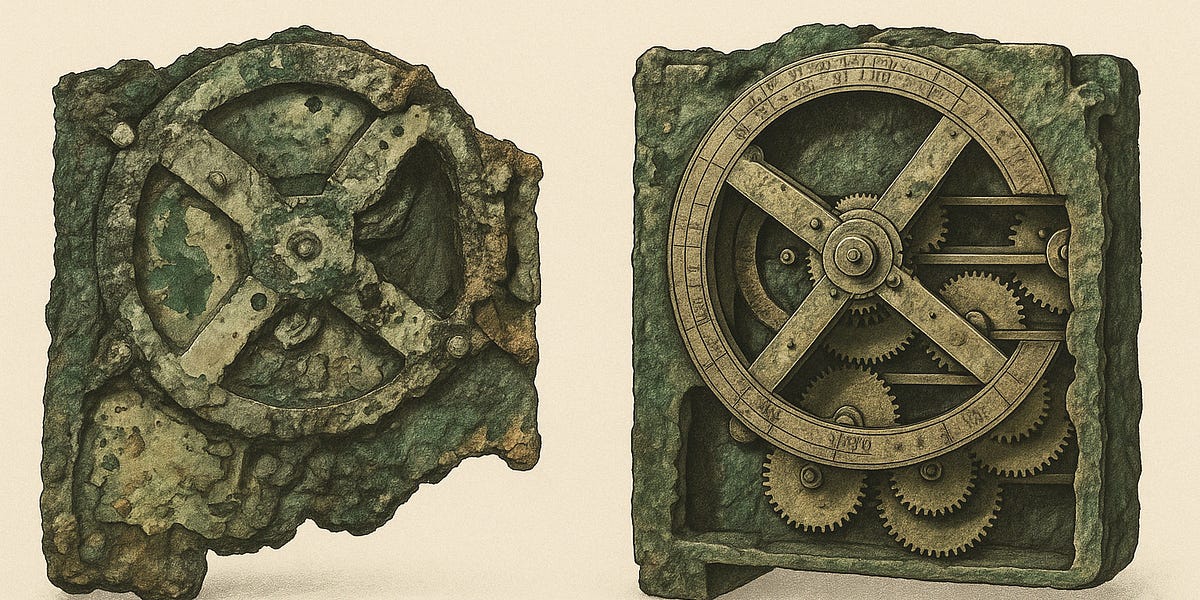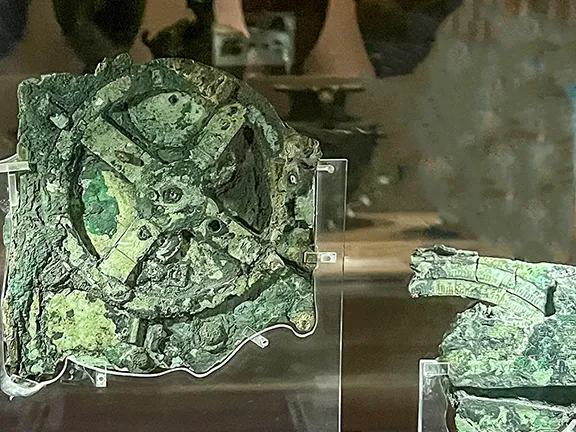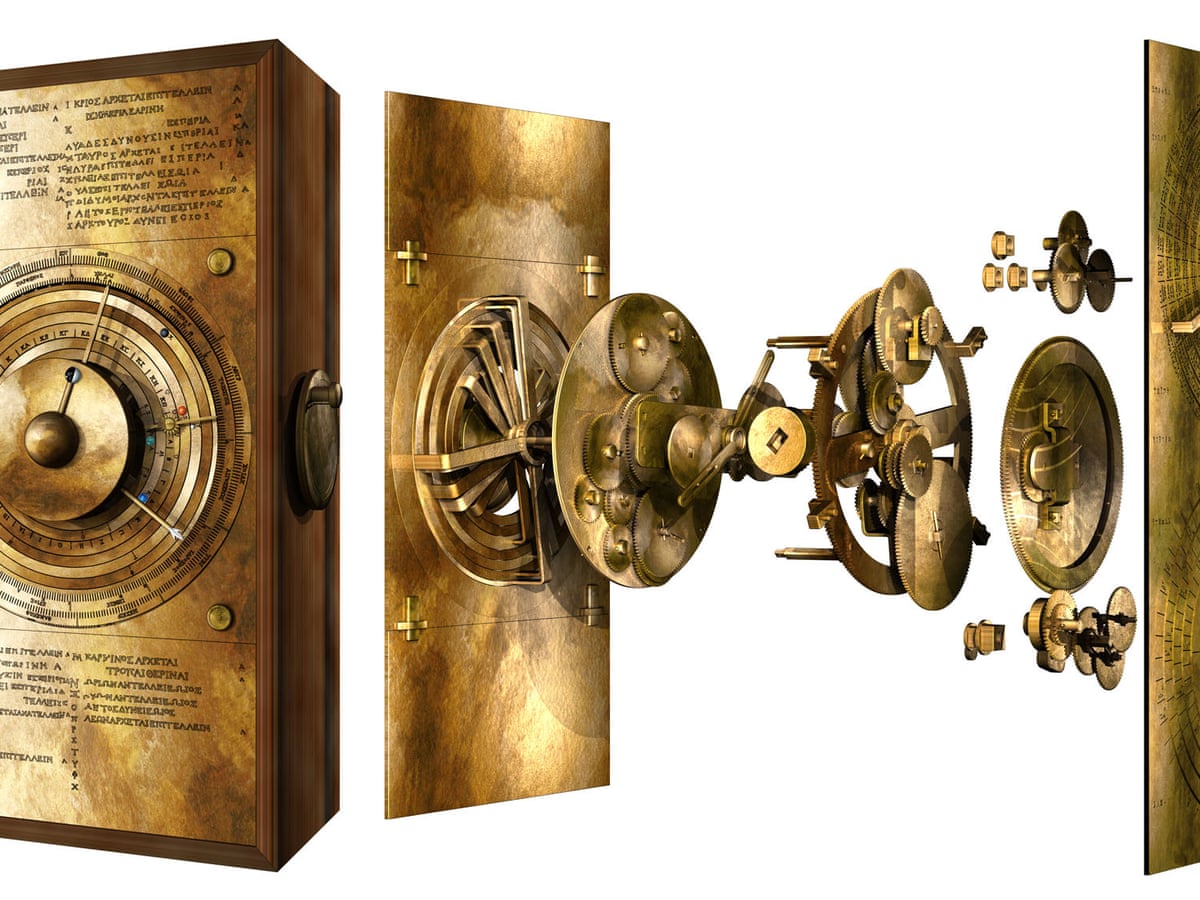In the spring of 1901, a group of sponge divers off the coast of a small Greek island thought they had found treasure. Their ship had dropped anchor near Antikythera, a rocky isle between Crete and the Peloponnese. Diving deep into the Aegean waters, the men began pulling up bronze statues, marble busts, and amphorae from what was clearly a sunken Roman-era ship. Among the haul was an unassuming, corroded lump of bronze and wood that looked more like debris than treasure.
For decades, no one thought much of it. The statues were shipped off to museums, and the lump of metal was stored away. Yet hidden inside that corroded mass was something extraordinary: a machine unlike anything the ancient world had ever revealed before.
That lump of gears would eventually be known as the Antikythera Mechanism — humanity’s first known computer.
A Machine Centuries Ahead of Its Time

At first glance, the mechanism seemed simple, a box roughly the size of a thick book. But careful study revealed over 30 finely crafted bronze gears, precision-cut and interlocking in ways thought impossible for 2,000 years ago. Turning a crank on the side would set the gears into motion, causing dials and pointers to track the movements of celestial bodies.
Built sometime between 150 and 100 BCE, the Antikythera Mechanism could:
-
Predict solar and lunar eclipses
-
Track the phases of the Moon
-
Chart the positions of the Sun and Moon in the zodiac
-
Possibly calculate planetary alignments
-
Even keep time for the ancient Olympic Games
Imagine a smartwatch made of bronze — no batteries, no screen, just a complex harmony of gears, wheels, and mathematical precision.
What shocked historians most wasn’t just the machine’s capability, but its sophistication. The device modeled the lunar anomaly (the irregular orbit of the Moon), something not scientifically described again until Johannes Kepler in the 1600s. In other words, Greek engineers had built a machine that encoded astronomical knowledge 1,500 years ahead of its rediscovery.
Discovery in a Shipwreck

The Antikythera Mechanism was found in the wreck of a Roman ship dating to the 1st century BCE. The vessel had likely been carrying treasures from the eastern Mediterranean to Rome — statues, jewelry, fine pottery, and, curiously, this lone device.
Why was it aboard? Some believe it belonged to a wealthy Greek scholar or noble who was transporting it to Italy. Others suggest it may have been looted from a library or workshop. The truth remains a mystery.
No other devices like it have ever been found. In fact, the next comparable gear-based astronomical clocks don’t appear until the 14th century in medieval Europe — over a millennium later. This “gap” has fueled endless speculation: Did the knowledge of such machines disappear in the chaos of history? Was it destroyed in the burning of the Library of Alexandria? Or was this mechanism simply a unique masterpiece, never replicated?
Who Built It? The Archimedes Connection

The identity of the mechanism’s creator is one of archaeology’s enduring mysteries.
Some scholars suspect ties to Archimedes of Syracuse, the legendary mathematician and inventor who died in 212 BCE. Others point to Hipparchus, the great astronomer who developed models of lunar and solar motion in the 2nd century BCE. Still others suggest it came from a workshop on Rhodes, a hub of astronomy and mechanics.
What we do know is that whoever built it had mastered a level of mechanical engineering thought impossible until the Renaissance. Precision gear teeth, complex ratios, and multi-layered gear trains suggest not only genius, but also access to advanced tools.
How the Mechanism Worked

At its core, the Antikythera Mechanism was an analog computer. A hand crank on the side powered the gears. On the front, dials displayed the position of the Sun and Moon against the zodiac, as well as lunar phases. On the back, additional dials tracked cycles:
-
The Metonic Cycle: A 19-year period aligning solar years and lunar months.
-
The Saros Cycle: An 18-year cycle used to predict eclipses.
-
The Callippic Cycle: A refinement of the Metonic cycle spanning 76 years.
Each cycle was encoded in carefully meshed gears, their ratios designed to mirror astronomical rhythms. Turning the crank let users simulate years of celestial movement in moments.
To put it in modern terms: this was predictive modeling software, built with bronze.
Rediscovery in the Digital Age

For much of the 20th century, the mechanism was little more than a curiosity. It wasn’t until the 1970s, with the rise of X-ray imaging, that researchers began to see the hidden gears inside. In the 2000s, breakthroughs came with CT scanning and 3D modeling, allowing scientists to virtually “unpack” the mechanism layer by layer.
Researchers like Tony Freeth and the University College London’s Antikythera Research Project reconstructed its workings in astonishing detail. They discovered inscriptions on the device, hidden mathematical formulas, and even indications that it might have tracked planetary positions for Mercury and Venus.
Machine learning and digital simulations further helped decode missing parts. What emerged was not a mystery clump of bronze, but a precise, intentional machine.
Why Was It Lost?

One of the most sobering lessons of the Antikythera Mechanism is that knowledge does not always progress in a straight line. It can leap forward — and vanish.
The fall of Greek city-states, the rise of Rome, and centuries of upheaval may have buried this knowledge. Roman society valued Greek art and philosophy but showed less interest in technical science. By the time Europe entered the Middle Ages, the mechanical knowledge behind the Antikythera Mechanism had disappeared.
When similar astronomical clocks reemerged in Europe over a thousand years later, they were hailed as revolutionary. Yet they were, in many ways, reinventions of what the Greeks had already built.
Lessons for Today

The Antikythera Mechanism is not just an archaeological marvel; it’s a parable for the modern world.
-
Knowledge is fragile: Without preservation, entire fields of science can be lost.
-
Innovation is cyclical: Progress doesn’t always march forward — it stumbles, regresses, and rediscovers.
-
Technology is cultural: The survival of inventions depends not just on their brilliance, but on the society that nurtures them.
For us in the digital age, it’s a call to document and safeguard knowledge. What if future generations looked back and found only fragments of our technology, as we did with the Antikythera Mechanism? Would they marvel at our brilliance — or wonder at what was lost?
Why It Still Inspires
Engineers, historians, and dreamers alike remain captivated by this ancient computer. For engineers, it is a reminder that precision mechanics existed long before silicon. For historians, it’s evidence that ancient civilizations were far more advanced than often assumed. For the public, it’s a story of wonder — proof that myths of lost knowledge may not be myths at all.
Today, replicas of the Antikythera Mechanism sit in museums around the world, built by modern artisans who have painstakingly reconstructed its gears. Yet even now, mysteries remain. Was this truly a one-of-a-kind device? Were there others? And if so, how much ancient knowledge has vanished beneath the tides of time?
Conclusion: A Machine Out of Time
The Antikythera Mechanism is often called a “computer lost in time,” and the phrase is apt. It embodies humanity’s oldest dream: to understand the heavens, to predict the future, to bring order to the cosmos through ingenuity.
It also embodies our deepest vulnerability: that knowledge, no matter how advanced, can be forgotten.
As we stare into the glowing screens of our digital world, it’s humbling to think that 2,000 years ago, someone turned a bronze crank and watched the future unfold on a set of dials. In that moment, they too were reaching for the stars, seeking to measure the mysteries of time.
Official Sources
-
Nature – Decoding the ancient Greek astronomical calculator known as the Antikythera Mechanism
-
Smithsonian Magazine – The Antikythera Mechanism: An Ancient Greek Computer
-
National Geographic – Scientists Unlock Secrets of the Antikythera Mechanism
-
Archaeology.org – The Antikythera Mechanism Research Project
